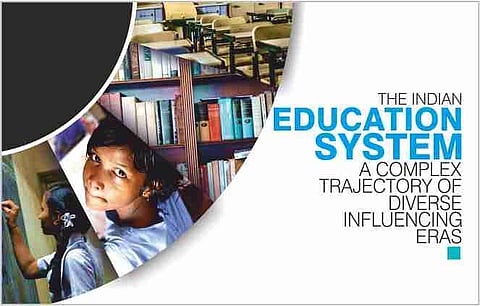

THE INDIAN EDUCATION SYSTEM, A COMPLEX TRAJECTORY OF DIVERSE INFLUENCING ERAS
THE INDIAN EDUCATION SYSTEM, A COMPLEX TRAJECTORY OF DIVERSE INFLUENCING ERAS
From where it all started, education in India has taken a complete flip from what it was and where it has reached today. The education system is highly dominated by universities, schools, colleges, institutes, etc.
Before we even begin to spell our name correctly, we are burdened with books, projects, homework, assignments, marks, exams, etc., but then we put this all under the spirit of competition. So many times the thinking process is led to believe that this exactly what education is all about, but, reality check, no it's not. Education is a never-ending process, of course, books, marks, exams, etc. being an important part to achieve greater heights, the true meaning of it is far from what the scene has become today.
THE MEDIEVAL ERA
India, on the whole, has witnessed tremendous growth in terms of achieving and spreading education in the due course of progress and has dramatically amplified in various aspects. The Indian education system dates back to the 'Vedic Age' where the helm of the system was under the hegemony of the saints. The era was of Gurukul, where anyone who was seeking knowledge would knock the door of a learned man and please him to receive knowledge.
Further, the student would live, eat, sleep, learn, help around the house chores, etc. at the teacher's place, which not just made the bond stronger but also gave the student a chance to learn household activities. The teachings were of all natures i.e. maths, physics, Holy Scriptures, Sanskrit and more. Everything taught was either close to life or nature and not just four walls and memorizing of theories one after another, earlier learning included plenty of practical knowledge.
It was Lord Babington Macaulay who introduced the modern schooling system in India in the 1830s. The curriculum streamlined subjects and got confined to modern systems. The lessons were later restricted to the four walls of a classroom and the relationship with practical knowledge, life and nature were completely taken away, and so was the bond between the student and the teacher.
THE POST INDEPENDENCE ERA
After more than 70 yrs of independence from British rule, India has come a long way in terms of structuring its education system. Everything has significantly changed with just a few things from the past. From the history of Gurukul to universities, institutes, colleges, and schools taking over the system and offering everything from kindergarten to a Ph.D. Globalization and advancement in technology today have made this country a hub of brilliant institutions and popular among students from foreign lands as well.
People of all ages can now receive education actively by both private and government educational institutes. Education today thankfully has unshackled itself from the chains of four walls and entered a more holistic approach scenario. The balance is now maintained between both extracurricular activities and classroom academics. The approach now is to comprehend that the activities like cultural events, sports, debates; group activities, etc. make an individual a better decision maker and enhance one's personality as well.
THE PRESENT ERA
Today, at both state and central levels, education is dispensed. The central body to decide the education policies, The National Council of Education Research and Training (NCERT) is coming up with the right kind of guidance and training modules for teachers and students.
'The Right to Free and Compulsory Education' was one of the primary fundamental rights that were constituted post the independence era by our then leaders that transformed the system of education for eternity. Thanks to these changes made, today, the India we live in is a country full of centres of higher education with international ranks. Education has taken different forms with a plethora of amenities; today we have a luxury of distance learning, open learning, special schools, the school for differently able, art, etc.
Over the years the literacy rate in India has amplified from the approximately a little more 10% at the time of British rule to more than 72% in the last few years, the growth has been tremendous and only looks like booming in the coming years. Rural India still is struggling with religion barriers and financial problems in terms of social lifestyle and to achieve a literacy rate of 100%, these things would need an urgent solution.
The manner of delivering education, over the years has transformed in ways of forms, face, and methods. Over the years the manner of teaching and learning may change, but what we have come to understand is that the truest essence of education i.e. to impart knowledge, does not change.
Follow us on Google News
